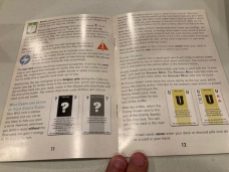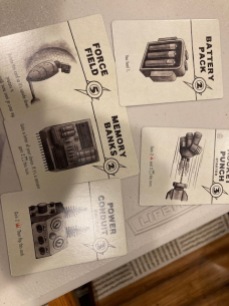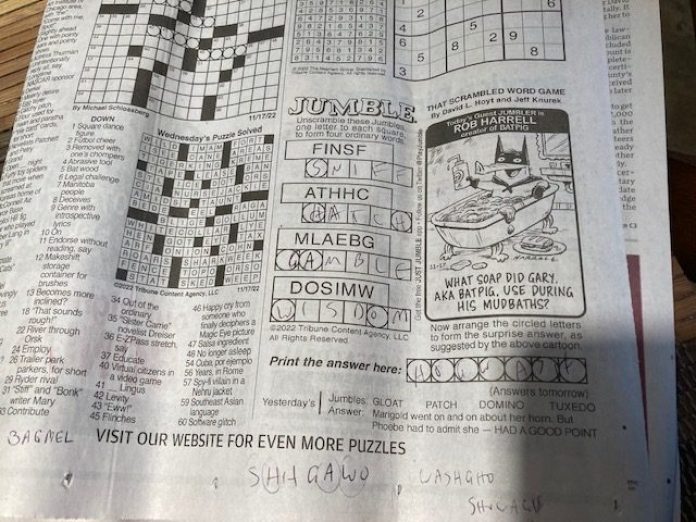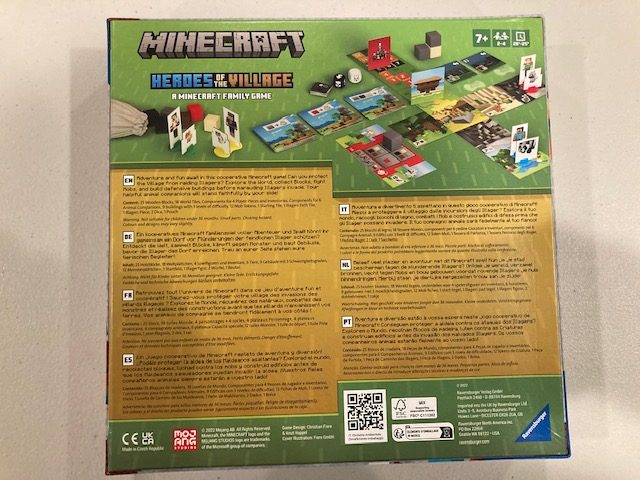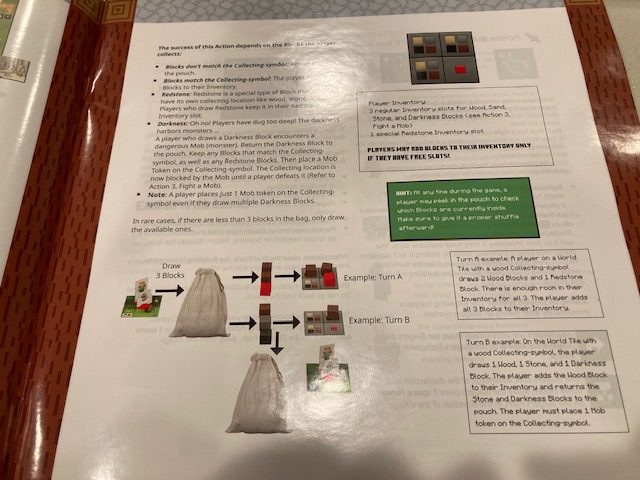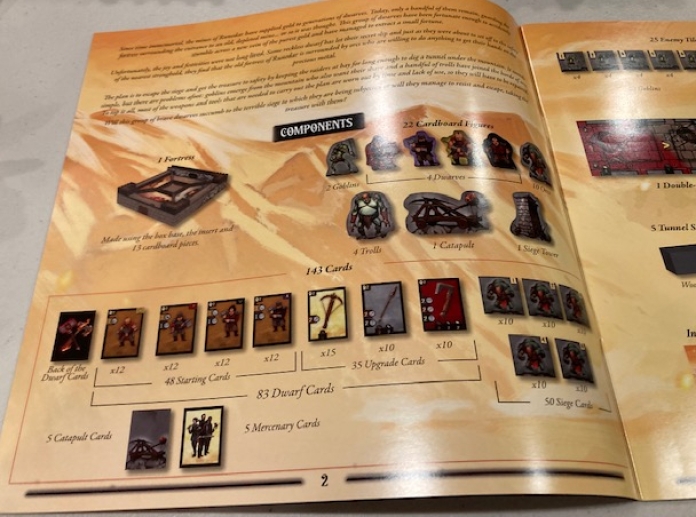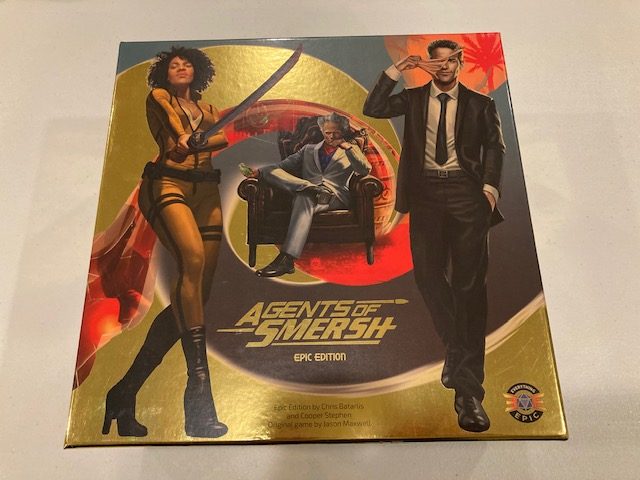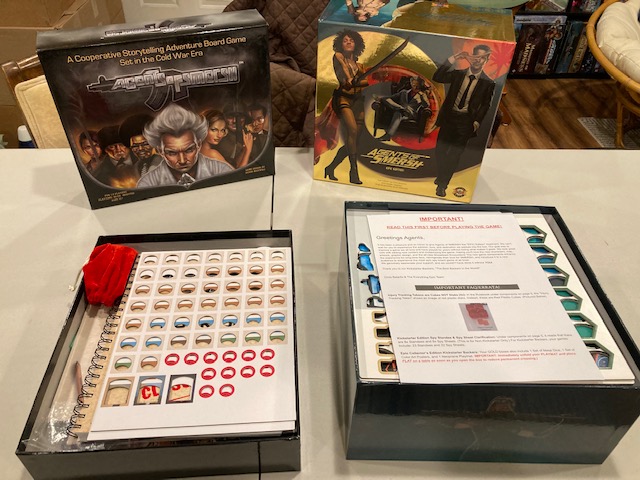
Paperback Adventures is a solo and cooperative deck-building word game. It was on Kickstarter a while ago, and I just received my copy recently (early November 2022). The campaign promised delivery in Feb 2022, so it was about 9 months late.

This game is weird in that if you get the core game, YOU STILL CAN’T PLAY IT! There’s a disclaimer on the back of the core box (see below), but I worry it’s still not prevalent enough!!

In order to play the game, you need the core box AND a character box: see above and below.

So, for the kickstarter, I went full in and got the core game, all 3 character boxes (Damsel, Plothook, and Ex Machina), and the playmat. It’s good to get all 3 boxes because at least one of the cooperative modes requires all three character boxes.
Let’s take a look and see what this is!
Unboxing The Core Box

Paperback Adventures is mostly a card game, with a few extra trinkets: see picture above with Coke can for scale.

It has a very nice but simple plastic insert that holds all the cards: see above.

The rulebook is decent (we’ll discuss that more below).

In the game, you will be fighting Lackeys and Bosses: this is a game about doing damage to bad guys. The lackeys/bosses are on larger cards like above and below.


When you defeat a Lackey or Boss, you get a Reward: see the Rewards cards above (even better, you get to choose which side of the Reward card you get!)!

A nice little plastic insert is included for holding the Lackey/Boss card. The outer edge for tracking 4 things: hit points (orange marker), hexes (purple marker), boons (yellow), and “current bad guy action” (blue). The little metal tokens for tracking look very nice.

This is a deck-building game, where your hand is made up solely of letters. In the game, you will spell words with the letters in your hand to make things happen. The core game comes with only two types of letters: Boss/Lackey vulnerability cards (the yellow cards above) and Penalty cards (red cards above). each Boss/Lackey has a vulnerability which is always a vowel: basically, you always get a free vowel from the vulnerability. The Penalty cards are letter cards that can clog your deck (every deck-builder has the idea of wounds or bad cards that clog your deck). The main letter cards will come from the character box.

The core game includes McGuffin cards which help the players. McGuffin is a literary term … If you don’t know what a McGuffin is:
Mc·Guf·fin/məˈɡəfin/noun
The idea is that you can earn McGuffins as you advance in the game. Each McGuffin has very special “powers” that help you. The purple or Boss McGuffins are better than the plain ones, as you have to defeat a Boss to get one.

The red McGuffins are ones you can buy (those are double-sided and you can choose which side) or get in other places.

One thing that’s kind of cool is that the game comes with sleeves! Most deck-builder games probably should be sleeved (since you handle the cards so much), and this one just comes with them. The letter cards get the really nice blue typewriter sleeves, and the other cards in the game get clear ones: see above.
One thing that struck me as weird initially is that the cards are linen-finished even though the game comes with a complete set of sleeves. I was originally not sure why they made this decision, but I think it’s because the way cards upgrade: When you upgrade a card in your hand, you take the card out of the sleeve and flip it around, so you still handle the cards! I suspect that’s why the cards are still linen-finished even though the game comes with sleeves.

Let me be clear: these letter sleeves are some of the nicest sleeves I have ever seen included with a game. That are very nice, fit well, feel nice (they aren’t too slippery) and really are classy. See above.

There are some other cards (like Items, which you can buy to help you) and Plot Twists (purple cards to help you).

The game has really nice components (modulo one one issue, which we’ll talk about later)!

The game even comes with some upgrades! After you defeat a Book 3, you can open the envelope above! (Note, the game even includes enough sleeves for the secret cards that get upgraded!)
Rulebook

This rulebook was pretty good, not great. The text-to-picture ratio is large (all that text is a little daunting when you page through the rulebook), but the pictures that are there are good. I feel like this was a better rulebook than the Burgle Bros 2 rulebook, so Tim Fowers rulebooks are getting better!

One minor complaint is the component list has no correlating picture: see above. Sigh: this slowed down my learning of the game. I would have love a full-page spread putting names and pictures of components together. However, the rulebook does have some notion of first play (“first journey”) and even highlights that “first journey” changes in a cyan color (see upper right on page above). This “first journey”does help ease you into your first game.

The game does set-up right: it shows a picture and annotates the picture with each step. This was great …

… and even though the set-up spanned multiple pages, the NEXT page had the updated picture! See above. That was great! The rulebook was constrained to being smaller, so this was a great compromise to set-up spanning multiple pages! You can also see the “first journey” cyan-colored text block (right) above.

The anatomy of some of the components had a nice annotations: see above. It reminded me of “hovering” over a web page and getting further elaborations (“bubble text”).
The rest of the rulebook was pretty text-heavy (see pages above), but in general it was pretty good.
One major complaint is that I had to open the character box in the middle of opening the core box when following the set-up instructions: I would have preferred some better way to to do this: “Open the Character Box and let’s look inside before we begin!” … or something like that.
I had some other complaints: I had to hold the rulebook open (it didn’t really stay open by itself), the components list didn’t have a correlating picture, and there was a lot of text later in the rules. But the game had pictures when it counted, examples when needed, and even referrals to web pages with FAQ for edge-case rules.
The rulebook was fine.
Character Box Unboxing

That’s right, I have to do a second unboxing because I need to have a character box to play with the core box! I chose to play my first game with “Plothook“: See above.

Most of the cards for your deck are in this box. All the stuff in the Core box are “some cards” you play with. The majority of the cards you use (at least for your hand: remember, this is a deck-building game) are the 60 Library cards come from this character box. You can see a component list on the back side of the box (above).

Your character is on the big card (“Plothook“) and describes some of the special powers.

You can see more of the high-quality sleeves for the letter cards.

Honestly, I can’t rave enough how great these sleeves were.
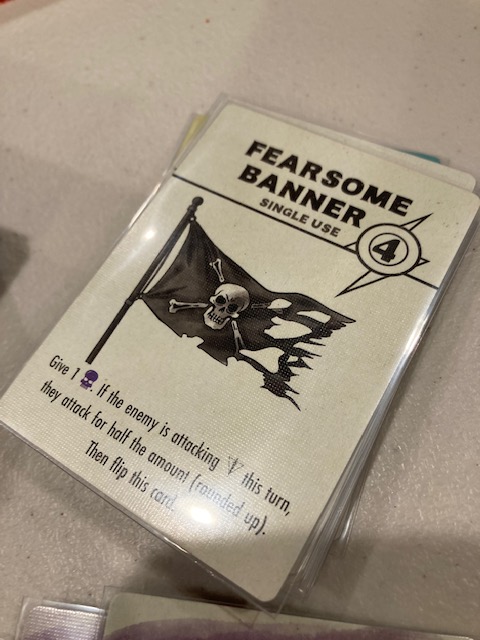
The character box also comes with some more McGuffins and Items (for more variety) plus a character plastic holder for the character card (with more metal tokens). Oh yes! And some more “Top Secret” cards to open if you beat Book3 Boss!! See below.

The components look really neat for the character, and very consistent with the core box. I like how the character box and associated items are color coded to make sure the character insert is a different color (purple) than the main bad guy color (orange).
Some Component Complaints

There are two problems with the components: one major and one minor. The major one is that the cool metal markers don’t work well in the plastic slots! See above, as the marker doesn’t fit! Sometimes it fits, and sometimes it doesn’t! Sometimes it stays, sometimes you have to work to fit it in! Sometimes it won’t even stay in!

I ended up just “lightly settling” the metal marker in the slots: see above. This works, but the metal markers are very precariously just set in the slot. This workaround unfortunately makes the game more susceptible to “knocks” to the game table. I think if the metal markers fit consistently into the slots, this would be a cool system! I love the metal markers and think they pop on the table. But they don’t work very well.

I was able to make the markers work and play through some games, but they didn’t work well: it was very deflating given how cool they look.

Another more minor issue is that some of the cards aren’t marked for which box they came from! For example, you can see the “Plothook” icon on the Cursed Ring card (above), so you know that item belongs in that box. But the other Items from the same box were NOT marked in anyways! The same was true for the McGuffins … you didn’t know which box they came from! There was no marker!!!
It’s weird because some cards and marked and some aren’t. I understand it’s “cool” that the Items and McGuffins are interchangeable in the game, but if I want to reset back a character to his own box so I can try another character in isolation, I have to be careful with my cards, or find a list of cards online to help me reset them. This was a minor complaint.
Word Game
Don’t be fooled by all the cool looking cards and components: at its core, Paperback Adventures is a word game like Jumble or Scrabble. In Jumble, you spell words with the given letters. In Paperback Adventures, you spell words with cards from your hand: the length of the word and character of those letters causes things to happen in the game! Words Have Power!

At the start of your turn, you get 4 cards to form a word with: there are lots of other places letters come from (The Enemy Vowel Card, a Wild, A Letter You Want), but your essential cards come from your hand. Above, I spelled “TEAR” … and you’ll notice all the little swords and energy symbols to the right of the card. This word TEAR does 5 damage and renews 1 energy! The top card of the hand might also activate: in this case, “Barrage (6)” (which means if I have a word of 6 cards, I activate the Barrage effect: since the word is only 4 letters, I do not activate it).

But the way you splay the word changes what it does! If I splay the same word to the right, I get different symbols and effects! In this case, I get 3 shields (which block damage) and 2 Energy! The top card also activates, so I gain 2 swords and give the Bad Guy a Hex!!
It was my experience that splaying right was defensive (blocking damage) and splaying left was offensive (causing damage). And the special ability on the top of the card was sometimes very helpful in still doing something useful even if you were just defending.

The top card (which had the special ability) gets put in a fatigue pile, which means it can’t be used until your next fight. As you fight, your deck gets smaller and smaller …

Each character you choose has special abilities: the definition of Barrage is on your character card above.

In the game, you must fight and defeat 6 Bad Guys to win! There is one Lackey, then one Boss per book! Over 3 books total, you will be fighting 6 Bad Guys one at a time. If you take all Bad Guys to 0 HP, you win! If you are reduced to 0 HP yourself, you lose! The orange marker tracks the Hit Points (HP): Above, you can see The Muscle has only 2 HP left after starting with 14!!

Each character starts with some special Items to help: the items are powered by Energy. The Cutlass requires 1 Energy to use (upper right on card) and the Parrot requires 0 Energy (upper right). Energy (as we saw earlier) is generated from the words you spell.
After you defeat Bad Guys, you get a two-sided cards which lets you choose upgrades!

After defeating the Muscle, I chose the side listed above! You get all the upgrades listed! Notice that the top upgrade allows you to add cards to your deck: this is the deck-building portion of the game we’ve been alluding to for some time. If you defeat a Boss, you get to add a card to your hand. If you defeat a Lackey, you only get to replace a card in your hand.

Where do the upgrades come from? In the upper right part of the bard is a 3×3 grid of cards: This is the Shop! there are letter card upgrades, item upgrades, and McGuffins you can “buy” (at the cost of Boons) for your hand!
As you play, you get more cards, more McGuffins, more Items, and just more stuff to help you build better words.
But, at the end of the day, you spell words to get stuff done: all the other stuff just helps you.

I spelled TODDLER above, using 2 wild cards, the Enemy Weakness Vowel (E), and my 4 base cards to spell a 7 letter word. Because the word was 7 letters, I still activate the Barrage: it needs 6 or more letters! But TODDLE is a word (just drop the final R), so with that, I can activate Barrage and get 10 swords of damage! Words Have Power!
Solo Game
Most games we look at here at Co-op Gestalt are cooperative games first and solo games second. Paperback Adventures is a solo game first with cooperative two-player variants second.

This is clearly a solo game first: the flow of the game just feels like a 1-Player game. And I loved it. The great thing about solo game is that you can have as much AP (Analysis Paralysis) as you like! If I want to take a while to play the game, that’s on me: I don’t hurt anyone else or waste anyone else’s time. I freely admit that I prefer to take my time in Word Games, so I liked that this was a solo game first.
Cooperative Game

Now, there are two variants for cooperative games: one that requires only one character box (called “Two-Headed Giant Mode”) and one that requires all three character boxes (called “2×2 mode”)! See above: that is the second-to-last page of the rulebook describing the two solo variants.

The best way to start is the “Two-Headed Giant Mode”: you can teach the game while you are both playing. You basically play one character with two people splitting the resources (this the “Two-Headed Giant Mode” designation). Essentially, the players sit next to each and alternate turns using the same character deck: the real difference is that the items and McGuffins are split between the two players. Since Items and McGuffins are split between the characters, the game is a little harder since each player has fewer abilities. The game overcomes this by allowing each player to get an Item or McGuffin when the Rewards would give just one: each player gets one.
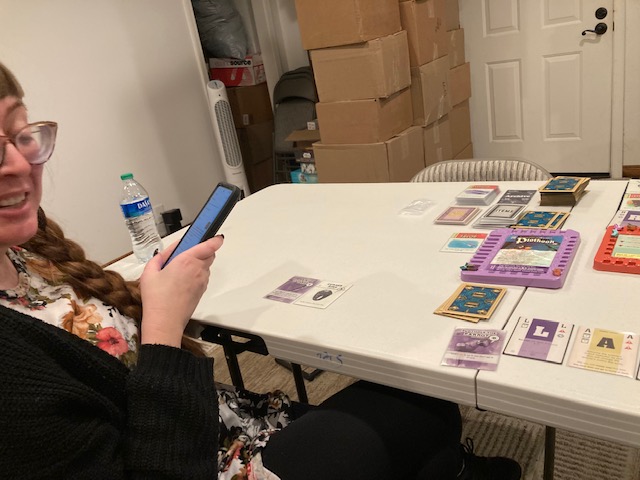
One concern I had was the at the “Two-Headed Giant” mode would be longer, and strictly speaking it is. But, we found it to be fun and very interactive!! It was surprisingly cooperative! We’d look at each others cards and make suggestions: I would see words my partner wouldn’t and vice-versa. We’d remind each other to use the items. We’d remind each other of the rules (each Bad Guys has its own distinct rules). The “Two-Headed Giant” mode was longer than the solo game, but not by too much. The extra time swapping players was made up for by having two brains concentrating on the game and the words. Honestly, it was really very fun.

The “2v2” cooperative game is much better once you both know the game, especially since both players can play simultaneously. There’s not much interaction between the two players in “2v2”, except for characters can buy letters from each other: generally, the “2v2” mode is more “two players playing the same game at the same time and very occasionally helping each other out”.
If you want more cooperation, discussion, and interaction: play the “Two-Headed Giant” mode, but it is a slower game. If you want just to hang with your friends and have much more limited interaction, play the “2v2” mode: the nice thing is that it is a much quicker game than the “Two-Headed Giant” mode, at the cost of some cooperation and interaction.
Unboxing Damsel
Unboxing Ex Machina
Will I Like This Game?
If you like word games, I think you will love this game! Paperback Adventures is the game I wish I had growing up. I have a confession: I am a very competitive Scrabble player .. and I become a jerk when I play. I have AP, I take too long, I take places so others won’t … I am not nice. And I get grumpy. I don’t like myself when I play Scrabble, so I simply don’t play it. But a cooperative or solo game where I have some AP and NOT be a jerk?? Sign me up!

Right before my Mom died, we played a lot of Word Games together. We’d do the Jumble in the morning together. We’d play light Scrabble, but not for points: we just spelled words on the table. This was some of the last memories I had of my Mom: playing Word Games with her. I wish I had Paperback Adventures around before she died: we could have played cooperatively together and enjoyed our time that much more together. I like Word Games. My Mom liked Word Games. This is a great game for me.

If the idea of spelling AUSTERE (see above) in a game sounds fun, then Paperback Adventures is the game for you! If spelling baroque words sounds like a miserable experience, then this is NOT the game for you. You have to like Word Games to like this game.
What I Liked: So Many Places With Choices!

I liked that there were a lot of places where you had choices on upgrades to get. For example: The Rewards cards (see above) you get after defeating a Bad Guy has two sides with slightly different upgrades: you get to choose which side!

The McGuffins also have two sides: when you take a McGuffin, you get to choose which side you want (you have to stick with that side though).

You also have plenty of choices for upgrading at the end of a battle: You go to the Shop and and spend your boon points!
You choose which way to splay your cards for different symbols! More choices!

I like that every Library cards has an ability on it: If I really want to use that, I have to come up with a word that starts or ends with that letter! My only limitation is my own vocabulary!

I also liked that every Bad Guy gives you a Vowel that you can always have (See above: the Sea Serpent always lets you have at least one E: the yellow card below). The Enemy Vowel fixes a MAJOR problem with Scrabble that we all know: “I have no vowels!” You are always guaranteed to have at least one vowel. And I really like the way this extra card is themed as the Bad Guy’s weakness! (A funny joke was that the Cthulu type card HAD no vowels, and that was his power!)

In general, I think the game gives you so many choices and so many ways to move forward! Even though this is still a word game at its core, the rules don’t straight-jacket your choices: there is a always some choice or way forward!
What I Don’t Like
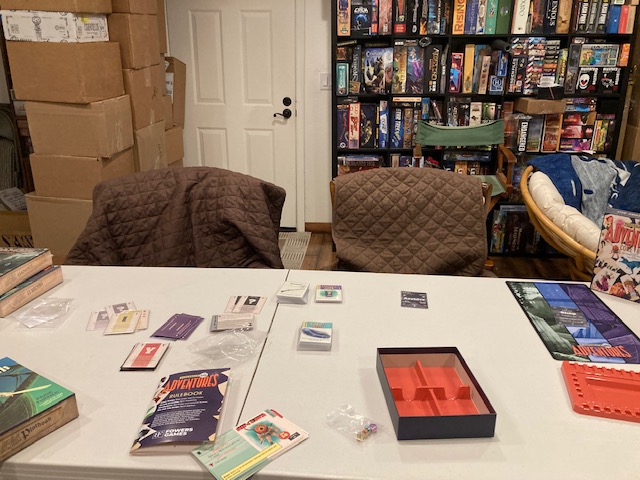
What don’t I like? The game is really long! The box says 90 minutes, and I say no way! It took me more than 2.5 hours to get through my first game, and it flowed very well. This could be my own Analysis Paralysis, but the game feels … maybe 30 minutes too long. The cooperative game took about 3 hours. That 90 minutes seems like a straight-up lie.

I’ve already complained about the metal tokens not working in the plastic insert, but it bears repeating: it is probably the biggest problem with the game. I love this game, and I was really annoyed with the tokens not fitting. Someone else who might like the game could get turned off immediately from the way the metal tokens DO NOT work. I ask you to persevere and get through this problem: Paperback Adventures is a good game (if you like Word Games).

I am also okay with the wacky way this game requires both the core box AND a character box, but I can easily see this causing someone to turn away from the game. “I need two boxes? What? That’s dumb”. Again, I ask you to persevere.
Conclusion

If you don’t like Word Games, run away now: Paperback Adventures is not for you. Although there’s a lot of great components, cool modern mechanisms, and upgrade paths in this game, the core game is a Word Game. You must like that core word game to like this game.
If you like Word Games and are looking for a great solo Word Game or a very good cooperative Word Game, Paperback Adventures is a fantastic choice. I really like this game because it appeals not only to my word affinity, but also to my hard-core gamer. There’s a myriad of choices, there’s a plethora of upgrades, there’s a gamut of strategies! All the while, the base word game is fun and works well. I would give this an 9/10. I love Word Games.
My friend Sara didn’t like Paperback Adventures as much as I did, but she’d still give it a 7/10 and would be happy to play it cooperatively again.

I wish I had this solo/cooperative Word Game growing up: I think I would have played Paperback Adventures a lot with my Mom. It’s unfortunate that I never got to play this with her.
Appendix

One of my complaints was that the cards are unmarked (for the most part) as to where they came from. In the Unboxing sections, I shows pictures of all the cards, items, and McGuffins for each character box. Hopefully this will be useful for future generations to sort their cards.


